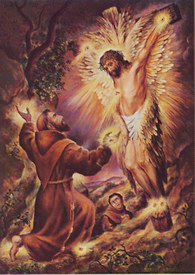Lives of the Saints
Our Models and Protectors
Spiritual Bouquet:
September 17

The Stigmata
of Saint Francis
(†1224)
Saint Bonaventure, biographer of Saint Francis of Assisi, wrote that two years before his holy death he had been praying on Mount Alverno in a solitary retreat, where he had gone to fast for forty days in honor of the Archangel Michael. No one ever meditated more than Francis on the Passion of his Lord. During his retreat he beheld in vision a six-winged Seraph attached to a cross, and received at the same time a painful wound of the heart, which seemed to transpierce it. When the vision ended his own hands and feet bore the marks of the angelic crucifixion which he had seen in the vision. He understood by his vision that the soul must come to resemble Christ by the ardors of its interior fire, rather than by any physical, exterior means. We reproduce here a meditation of the saintly 19th century Abbot, Dom Guéranger of Solemnes in France:
The Feast of the Stigmata of Saint Francis, whom we will soon honor again on his feast of October 4th, is not only to glorify a Saint; it commemorates and signifies something which goes beyond the life of any single man, even one of the greatest of the Church. The God-Man never ceases to live on in His Church, and the reproduction of His own mysteries in this Spouse whom He wants to be similar to Himself, is the explanation of history.
In the thirteenth century it seemed that charity, whose divine precept many no longer heeded, concentrated in a few souls the fires which had once sufficed to inflame multitudes. Sanctity shone as brilliantly as ever, but the hour for the cooling of the brazier had struck for the peoples. The Church itself says so today in its liturgy, at the Collect: Lord Jesus Christ, when the world was growing cold, You reproduced the sacred marks of Your passion in the body of the most blessed Francis, in order that Your love might also set our hearts afire.' The Spouse of Christ had already begun to experience the long series of social defections among the nations, with their denials, treasons, derision, slaps, spittings in the very praetorium, all of which conclude in the legalized separation of society from its Author. The era of the Passion is advanced; the exaltation of the Holy Cross, which for centuries was triumphant in the eyes of the nations, acquires in the sight of heaven, as the Angels look down upon it, the aspect of an ever closer resemblance with the Spouse to the sufferings of her crucified Beloved.
Saint Francis, loved today by all who know of him — and few there are who do not — was like precious marble placed before an expert sculptor. The Holy Spirit chose the flesh of the seraph of Assisi to express His divine thought, thus manifesting to the world the very specific direction He intends to give to souls thereafter. This stigmatization offers a first example, a complete image, of the new labor the divine Spirit is meditating — total union, on the very Cross of Christ itself, of the mystical Body with the divine Head. Francis is the one honored by this primacy of choice; but after him the sacred sign will be received by others, who also personify the Church. From this time on, the Stigmata of the Lord Jesus will be at all times visible, here and there on this earth.
L'Année liturgique, by Dom Prosper Guéranger (Mame et Fils: Tours, 1919), The Time after Pentecost V, Vol. 14, translation O.D.M.